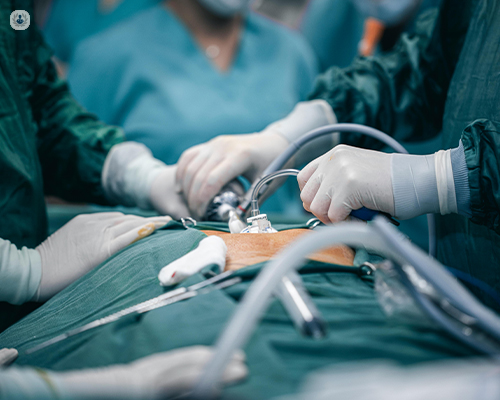Laparoscopic hysterectomy: What you need to know
Written in association with:Laparoscopic hysterectomy is a modern, minimally invasive surgical procedure to remove the uterus, offering a faster recovery and fewer complications compared to traditional open surgery.
Mr Richard Husicka, distinguished Consultant Obstetrician and Gynaecologist, provides an expert insight into laparoscopic hysterectomy, discussing why it is carried out, how it is performed, and what the recovery involves.

Why is a laparoscopic hysterectomy carried out?
A laparoscopic hysterectomy may be recommended for conditions like:
- Uterine fibroids: Non-cancerous growths in the uterus that can cause heavy bleeding, pain, and pressure.
- Endometriosis: A condition where tissue similar to the uterine lining grows outside of the uterus, causing pain and fertility issues.
- Endometrial hyperplasia of endometrial cancer.
- Pre-cancerous changes on the cervix.
- Uterine prolapse: A condition where the uterus descends into the vaginal canal due to weakened pelvic muscles. Although hysterectomy in cases of prolapse is mostly done vaginally, in cases where the ovaries and fallopian tubes need to be removed, a vaginal hysterectomy can be assisted laparoscopically.
How is the procedure performed?
Laparoscopic hysterectomy is a minimally invasive surgery performed under general anaesthesia to ensure your comfort.
Your gynaecologist will begin by inflating the abdomen with carbon dioxide gas to allow for better visibility of the organs. Small incisions (usually 0.5-1cm) will then be made in the abdomen to serve as entry points for the laparoscope (a thin tube with a camera attached at the tip) and the specialised surgical instruments.
Once the surgical tools have been inserted into the body, your gynaecologist will use the surgical instruments to carefully detach the uterus from the surrounding tissues. Depending on the underlying condition being treated, the uterus will be removed either in one piece vaginally, in pieces through the incision on the abdomen, or after morcellation in a containment bag.
Lastly, the carbon dioxide will be released from the abdomen and the incisions will be closed with sutures or surgical glue. The entire procedure will typically take between 1 to 2 hours, but the exact duration will depend on the complexity of each case.
Will the surgery remove my ovaries or cervix as well?
Whether your ovaries or cervix are removed will depend on the type of laparoscopic hysterectomy being performed, the underlying condition being treated, and your individual treatment plan.
In a total laparoscopic hysterectomy, all of the uterus - including the cervix - will be removed.
In a subtotal (supracervical) hysterectomy, only the body of the uterus will be removed whilst the cervix is left intact. This might be an option of choice specifically for younger, premenopausal women, leaving them with normal anatomy of the cervix and vagina, whilst the cause of the problem (bleeding, fibroids) is removed with the uterine body.
With a unilateral or bilateral salpingo-oophorectomy, one or both ovaries and the fallopian tubes will be removed, often recommended in cases involving cancer or to reduce the risk of later ovarian/tube-related conditions.
The general rule is to leave the ovaries intact in premenopausal women to preserve hormonal production, but the decision to remove the ovaries and/or fallopian tubes or cervix will depend on your individual health needs, reproductive plans and medical indications, and this will be your decision after a detailed consultation and discussion.
Are there any risks or potential complications involved?
While laparoscopic hysterectomy is generally considered safe, as with any surgery, there are potential risks, including bleeding, infection, or damage to nearby organs. Blood clots and anaesthesia-related complications are also possible but not common.
You should seek immediate medical attention if you experience severe pain, heavy vaginal bleeding, fever, or signs of infection at the incision sites.
What is the recovery process like?
Recovery after a laparoscopic hysterectomy is typically faster than recovery from open surgery. After the operation, you will be closely monitored before being discharged, typically the morning after the procedure.
During the first few weeks, mild abdominal discomfort, bloating, or fatigue is common. Light vaginal bleeding or spotting is also common. Pain is usually well manageable with prescribed medications, and over-the-counter options will suffice for minor discomfort.
Most patients will return to light activities within a few days and resume normal routines, (including work) in 2 to 4 weeks, but this is individual and depends also on the type of work. Full recovery, including the healing of internal tissues, will take at least 4 to 6 weeks.
If you would like to book an appointment with Mr Richard Husicka, head on over to his Top Doctors profile today.


